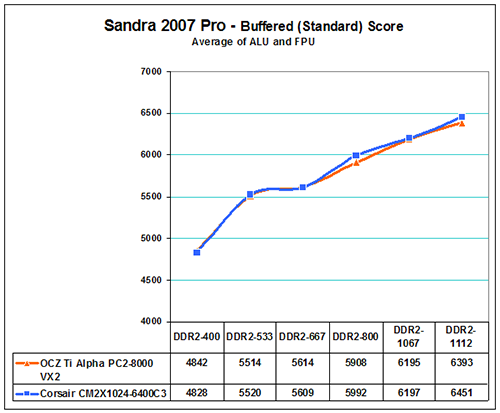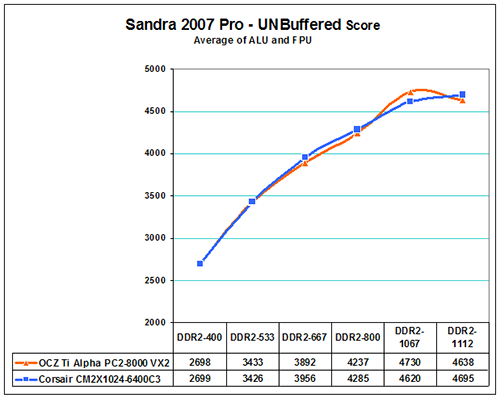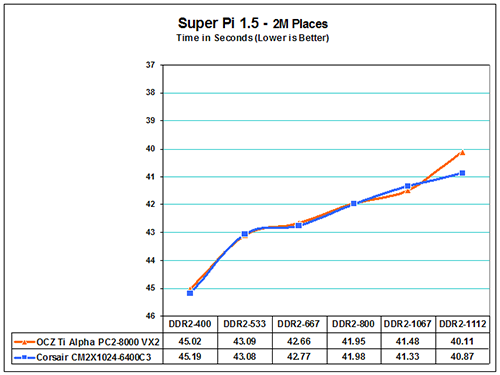Corsair and OCZ: New Standards in Fast DDR2
by Wesley Fink on August 4, 2006 5:50 AM EST- Posted in
- Memory
Memory Bandwidth and Scaling
Everyone should already know that memory bandwidth improves with increases in memory speed and reductions in memory timings. We first used the new Memory Performance Scaling charts in our comparison of DDR2 memory on AM2 and Core 2 Duo processors. They were so well-received the scaling charts will be used in future memory reviews to compare both Memory Bandwidth and Memory Performance over a wide range of DDR2 speeds. To evaluate memory bandwidth SiSoft Sandra 2007 Professional was used to provide a closer look at scaling.
Since the Corsair and OCZ results were so close at all tested speeds, the scale range was reduced to better show the small differences in these two memories. Please keep this in mind when viewing the charts, since a normal zero scale would make performance differences appear much smaller than these expanded scale charts. Values for each memory at each speed are included below each chart for reference.

The most widely reported Sandra score is the Standard or Buffered memory score. This benchmark takes into account the buffering schemes like MMX, SSE, SSE2, SSE3, and other buffering tools that are used to improve memory performance. We found in our recent AM2/NetBurst/Conroe comparison that AM2 provides the highest buffered bandwidth available - with leads at DDR2-800 as large as 40% over Conroe and NetBurst. NetBurst is next fastest, and Core 2 Duo provides the poorest Buffered bandwidth. Of course this does not carry through to other performance areas, as Core 2 Duo is normally 10% to 30% faster than AM2 or NetBurst in our system benchmarks.
Performance of the Corsair and OCZ are so close in Buffered bandwidth they could almost be from the same company.
As we have been saying for years, however, the Buffered benchmark does not correlate well with real performance in games on the same computer. For that reason, our memory bandwidth tests have always included an UNBuffered Sandra memory score. The UNBuffered result turns off the buffering schemes, and we have found the results correlate well with real-world performance.

In Unbuffered tests we see the Corsair 6400C3 and OCZ PC2-8000 again looking like they could be two samples off the same production line. Since both are based on specially binned Micron memory chips this should not be a real surprise.
The Sandra memory score is really made up of both read and write operations. It is also a synthetic benchmark that does not always reflect real world performance. We also compared pure number crunching with Version 1.5 of Super Pi - comparing the time to calculate 2 million places of Pi at the different memory speeds.

The most striking result in comparing Super Pi results is that performance continues to improve all the way to the highest speed that could be reached with stability - DDR2-1112 on both memories. The performance scaling illustrates how DIMMs with the same memory chips perform about the same. The only real difference between the Corsair and OCZ is the slightly better performance of Corsair at DDR2-1067 and the performance advantage of OCZ at DDR2-1112 - probably a result of the different approaches to SPD programming. Don't make much of these differences, however, as you can see similar difference in DIMMs coming off the same production line.
Everyone should already know that memory bandwidth improves with increases in memory speed and reductions in memory timings. We first used the new Memory Performance Scaling charts in our comparison of DDR2 memory on AM2 and Core 2 Duo processors. They were so well-received the scaling charts will be used in future memory reviews to compare both Memory Bandwidth and Memory Performance over a wide range of DDR2 speeds. To evaluate memory bandwidth SiSoft Sandra 2007 Professional was used to provide a closer look at scaling.
Since the Corsair and OCZ results were so close at all tested speeds, the scale range was reduced to better show the small differences in these two memories. Please keep this in mind when viewing the charts, since a normal zero scale would make performance differences appear much smaller than these expanded scale charts. Values for each memory at each speed are included below each chart for reference.

The most widely reported Sandra score is the Standard or Buffered memory score. This benchmark takes into account the buffering schemes like MMX, SSE, SSE2, SSE3, and other buffering tools that are used to improve memory performance. We found in our recent AM2/NetBurst/Conroe comparison that AM2 provides the highest buffered bandwidth available - with leads at DDR2-800 as large as 40% over Conroe and NetBurst. NetBurst is next fastest, and Core 2 Duo provides the poorest Buffered bandwidth. Of course this does not carry through to other performance areas, as Core 2 Duo is normally 10% to 30% faster than AM2 or NetBurst in our system benchmarks.
Performance of the Corsair and OCZ are so close in Buffered bandwidth they could almost be from the same company.
As we have been saying for years, however, the Buffered benchmark does not correlate well with real performance in games on the same computer. For that reason, our memory bandwidth tests have always included an UNBuffered Sandra memory score. The UNBuffered result turns off the buffering schemes, and we have found the results correlate well with real-world performance.

In Unbuffered tests we see the Corsair 6400C3 and OCZ PC2-8000 again looking like they could be two samples off the same production line. Since both are based on specially binned Micron memory chips this should not be a real surprise.
The Sandra memory score is really made up of both read and write operations. It is also a synthetic benchmark that does not always reflect real world performance. We also compared pure number crunching with Version 1.5 of Super Pi - comparing the time to calculate 2 million places of Pi at the different memory speeds.

The most striking result in comparing Super Pi results is that performance continues to improve all the way to the highest speed that could be reached with stability - DDR2-1112 on both memories. The performance scaling illustrates how DIMMs with the same memory chips perform about the same. The only real difference between the Corsair and OCZ is the slightly better performance of Corsair at DDR2-1067 and the performance advantage of OCZ at DDR2-1112 - probably a result of the different approaches to SPD programming. Don't make much of these differences, however, as you can see similar difference in DIMMs coming off the same production line.










18 Comments
View All Comments
Beaner - Friday, August 4, 2006 - link
Just curious...The picture of the Corsair DIMMs show the bottom one as 512MB.
Was the wrong one used for the photo?
JarredWalton - Friday, August 4, 2006 - link
The model name is correct at the top of the sticker, so I'm guessing it's a pre-release sample and the "512MB" is simply a typo. As Wes mentions, it doesn't appear that Corsair has an equivalent 2x512MB kit (yet?).CrappyLuckMan - Friday, August 4, 2006 - link
I would still like to see how budget DDR2-800 performs too. For some reason you guys left them out of the feeding the monster article. Do you guys think it's better to just go with value PC5300/5400 and overlock it? However, I would think you could overlock value DDR2-800 to around 1000mhz. In honesty I'm posting this out of selfishness since I ordered Corsair XMS2 1GB kit (my games I run never hit 1GB PF usage) TWIN2X1024-5400C4 4-4-4-12 1.9V for $108 is great for relatively low latency low voltage highly compatible ram.Your articles with specifics such as voltage and latencies you use for stable overclocks really save us users some time and we thank you for that.
CrappyLuckMan - Friday, August 4, 2006 - link
Oops made a bad com error. I should mention I meant to say it would be nice to compare which is better, lower latency lower voltage value pc5300/5400 or higher volt higher latency value pc6400 ram. Sorry tired from waiting on news for new motherboards last night lol.EarthsDM - Friday, August 4, 2006 - link
Wesley,In the discussion of his article, “Conroe Buying Guide: Feeding the Monster” (July 19th, 2006) Gary Key replied to a question on G.Skill memory, saying “We still have additional memory selections from a variety of suppliers arriving for further memory reviews at this time.” Is this what he meant, or are you guys going to review the G.Skill? I don’t want to sound ungrateful for the reviews you do, but G.Skill is a memory that of a lot of us (system builders) are interested in because it seems to offer the best performance/price.
On a separate but related note, do you know when the next round of motherboard reviews will be posted? I’m sitting on some Core 2 Duos and I need systems to put them in for back-to-school. Thanks a bunch!
-EarthsDM
Wesley Fink - Friday, August 4, 2006 - link
We have the latest G. Skill on the way. We will schedule a review when it arrives.EarthsDM - Friday, August 4, 2006 - link
Thanks!yacoub - Friday, August 4, 2006 - link
The enthusiast, by definition, is always looking for more - more speed, more power, more performance. The quest is for the best - performance so good and speeds so fast that no one can touch their results. You may even consider the enthusiast an elitist, but that is no different than the car enthusiast, a photography enthusiast, or any technology area where hobbyists can be found.Well that's your opinion and I'd disagree with it. Enthusiast does not always equal elitist (in fact it rarely does) nor a need to have the most expensive and latest item. One can be an enthusiast of cars without owning an exotic supercar. One can be a photography enthusiast without ever taking a picture, but simply appreciating the work of others.
I'm not picking a nit, but pointing out the fallacy that if you buy the most expensive and newest item you must be an ethusiast. On the contrary, (reviewers excluded) you're most likely just a sucker for marketing or poor monetary management.
Most computer enthusiasts for that matter are much more interested in building the best bang-for-the-buck system, not the most expensive one they can find, and generally not even using the latest parts. I would say the overclocker is the epitome of the computer enthusiast, as 'he' not only looks for the best performance but often elicits it 'him'self by taking budget parts and using 'his' knowledge and resources available, runs them at the speeds of much more expensive items, thus getting the best of both worlds - cost and performance.
Just a thought.
Wesley Fink - Friday, August 4, 2006 - link
The most expensive is not always the best performance, as we have pointed out many times. The enthusiast seeks the best. The quest for best performance for "x" dollars is also seeking the best. So is overclocking a cheap part for best performnace.I suppose my point was that the enthusiast is not one to "settle" for mediocrity or buy a cookie-cutter system. Your points are well taken and I am in basic agreement.
yacoub - Friday, August 4, 2006 - link
Then they aren't elistists, as elistist brings to mind a rich person who just buys the latest and greatest because 'it is'. Overclockers are economical people to a fault. The two don't match up, hence the discrepancy. =)